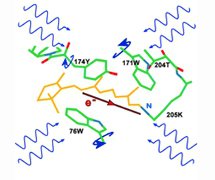Kenneth Foster

Kenneth Foster
Professor Emeritus
CONTACT
Physics
375 Physics Building
Email: kwfoster@syr.edu
PROGRAM AFFILIATIONS
Biophysical Science
- How visual receptors detect light and GPCR receptors activate.
- The self-organized beating of cilia.
- Sensory and metabolic control of ciliary behaviors; phototaxis, object avoidance, the ballistic-diffusive ratio, etc.
- Nonlinear dynamics of biological-cell signal processing; complex mapping of multiple signal inputs to responses.
- How small aquatic organisms and larvae steer and navigate in three dimensions without sensing gravity.
Research Spotlight

A photon (blue) excites chromophore (orange) triggering electron motion, which flips the direction of the 109 V/m electric field, rotates amino acid residues (green) and activates rhodopsin leading to sight
1972 Ph.D. in Biophysics
California Institute of Technology 1965 B.Sc. (Honors) in Physics
University of Victoria, Canada
Foster, Kenneth W., Jureepan Saranak, Sonja Krane, Randy L. Johnson, Koji Nakanishi (2011). “Evidence from Chlamydomonas on the photoactivation of rhodopsins without isomerization of their chromophore”. Chemistry & Biology 18, 733–742.
Blair, Howard A., Jureepan Saranak and Kenneth W. Foster. (2011) "Reverse engineering cellular decisions for hybrid reconfigurable network modeling" in Independent Component Analyses, Wavelets, Neural Networks, Biosystems, and Nanoengineering IX, Harold Szu and Liyi Dai (eds.) Proc. of SPIE Vol. 8058, 80581L, pp. 80581L-1 -- 80581L-14.
Foster, K.W. (2009). Eye evolution: Two eyes can be better than one. Curr. Biol. 19, R208–R210.
Josef, K., Saranak, J., and Foster, K.W. Linear systems analysis of the ciliary steering behavior associated with negative-phototaxis in Chlamydomonas reinhardtii. Cell Motility & the Cytoskeleton 63:758-777 (2006).
Saranak, J., and Foster, K.W. The Photoreceptor for Curling Behavior in Peranema trichophorum and the Evolution of Eukaryotic Rhodopsin, Eukaryotic Cell (4 (10) 1605-1612 (2005).
